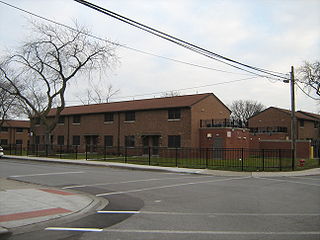
A toxic heavy metal is any relatively dense metal or metalloid that is noted for its potential toxicity, especially in environmental contexts. The term has particular application to cadmium, mercury and lead, all of which appear in the World Health Organization's list of 10 chemicals of major public concern. Other examples include manganese, chromium, cobalt, nickel, copper, zinc, silver, antimony and thallium.

Tap water is water supplied through a tap, a water dispenser valve. In many countries, tap water usually has the quality of drinking water. Tap water is commonly used for drinking, cooking, washing, and toilet flushing. Indoor tap water is distributed through indoor plumbing, which has existed since antiquity but was available to very few people until the second half of the 19th century when it began to spread in popularity in what are now developed countries. Tap water became common in many regions during the 20th century, and is now lacking mainly among people in poverty, especially in developing countries.

Lead poisoning, also known as plumbism and saturnism, is a type of metal poisoning caused by lead in the body. Symptoms may include abdominal pain, constipation, headaches, irritability, memory problems, infertility, and tingling in the hands and feet. It causes almost 10% of intellectual disability of otherwise unknown cause and can result in behavioral problems. Some of the effects are permanent. In severe cases, anemia, seizures, coma, or death may occur.

Lead paint or lead-based paint is paint containing lead. As pigment, lead(II) chromate, lead(II,IV) oxide,, and lead(II) carbonate are the most common forms. Lead is added to paint to accelerate drying, increase durability, maintain a fresh appearance, and resist moisture that causes corrosion. It is one of the main health and environmental hazards associated with paint. Lead paint has been generally phased out of use due to the toxic nature of lead. Alternatives such as water-based, lead-free traffic paint are readily available.
A corrosion inhibitor or anti-corrosive is a chemical compound added to a liquid or gas to decrease the corrosion rate of a metal that comes into contact with the fluid. The effectiveness of a corrosion inhibitor depends on fluid composition and dynamics. Corrosion inhibitors are common in industry, and also found in over-the-counter products, typically in spray form in combination with a lubricant and sometimes a penetrating oil. They may be added to water to prevent leaching of lead or copper from pipes.
Radon mitigation is any process used to reduce radon gas concentrations in the breathing zones of occupied buildings, or radon from water supplies. Radon is a significant contributor to environmental radioactivity and indoor air pollution. Exposure to radon can cause serious health problems such as lung cancer.

The Lead and Copper Rule (LCR) is a United States federal regulation that limits the concentration of lead and copper allowed in public drinking water at the consumer's tap, as well as limiting the permissible amount of pipe corrosion occurring due to the water itself. The U.S. Environmental Protection Agency (EPA) first issued the rule in 1991 pursuant to the Safe Drinking Water Act (SDWA). The EPA promulgated the regulations following studies that concluded that copper and lead have an adverse effect on individuals. The LCR limits the levels of these metals in water through improving water treatment centers, determining copper and lead levels for customers who use lead plumbing parts, and eliminating the water source as a source of lead and copper. If the lead and copper levels exceed the "action levels", water suppliers are required to educate their consumers on how to reduce exposure to lead. In a 2005 report EPA stated that the LCR requirements had been effective in 96 percent of systems serving at least 3,300 people.

Altgeld Gardens Homes is a Chicago Housing Authority (CHA) public housing project on the far south side of Chicago, Illinois, United States, on the border of Chicago and Riverdale, Illinois. The residents are 97% African-American according to the 2000 United States Census. Built between 1944 and 1945 with 1,498 units, the development consists primarily of two-story row houses spread over 190 acres (0.77 km2).
Drinking water quality in the United States is generally safe. In 2016, over 90 percent of the nation's community water systems were in compliance with all published U.S. Environmental Protection Agency standards. Over 286 million Americans get their tap water from a community water system. Eight percent of the community water systems—large municipal water systems—provide water to 82 percent of the US population. The Safe Drinking Water Act requires the US EPA to set standards for drinking water quality in public water systems. Enforcement of the standards is mostly carried out by state health agencies. States may set standards that are more stringent than the federal standards.

While performing research into premature pipe corrosion for the District of Columbia Water and Sewer Authority (WASA) in 2001, Marc Edwards, an expert in plumbing corrosion, discovered lead levels in the drinking water of Washington, D.C., at least 83 times higher than the accepted safe limit. He found that the decision to change from chlorine to chloramine as a treatment chemical had caused the spike in lead levels. The contamination has left thousands of children with lifelong health risks and led to a re-evaluation of the use of monochloramine in public drinking-water systems

Marc Edwards is a civil engineering/environmental engineer and the Charles Edward Via Professor of Civil and Environmental Engineering at Virginia Tech. An expert on water treatment and corrosion, Edwards's research on elevated lead levels in Washington, DC's municipal water supply gained national attention, changed the city's recommendations on water use in homes with lead service pipes, and caused the Centers for Disease Control and Prevention to admit to publishing a report so rife with errors that a congressional investigation called it "scientifically indefensible." He is considered one of the world's leading experts in water corrosion in home plumbing, and a nationally recognized expert on copper corrosion. He is also one of the whistleblowers in the Flint water crisis, along with Dr. Mona Hanna-Attisha.

Lead-based paint was widely used in the United States because of its durability. The United States banned the manufacture of lead-based house paint in 1978 due to health concerns.
Encasement is the coating over, covering or "encasing" of all building components, interior and exterior. This includes all roofing and toxic hazards materials, such as asbestos, lead-based paint, mold/mildew and other harmful substances, found in buildings. The technique of encasing all building components, including unsafe ones, with green coatings is by far the most efficient way to reduce the harmful effects on people and the environment while lengthening the life of buildings. It is an economical alternative to other abatement methods such as removal, disposal and replacement.
Lead contamination in Oakland represents a serious and persistent public health threat. Lead contamination in modern Oakland comes from three primary sources: remnants from previous industry, deposits from leaded gasoline, and paint chips from leaded paints. Significant portions of the City of Oakland, California have soil lead levels far in excess of 400 ppm, the level at which the US EPA suggests remedial action be taken, and far higher than 80 ppm, the level at which California’s Office of Environmental Health Hazard Assessment suggests action should be taken. Not all areas of Oakland are affected equally: West Oakland's contamination is especially severe, particularly near the former Oakland Army Base, and many of Oakland's poorer neighborhoods also suffer disproportionately.

The Flint water crisis was a public health crisis that started in 2014 after the drinking water for the city of Flint, Michigan was contaminated with lead and possibly Legionella bacteria. In April 2014, during a financial crisis, state-appointed emergency manager Darnell Earley changed Flint's water source from the Detroit Water and Sewerage Department to the Flint River. Residents complained about the taste, smell, and appearance of the water. Officials failed to apply corrosion inhibitors to the water, which resulted in lead from aging pipes leaching into the water supply, exposing around 100,000 residents to elevated lead levels. A pair of scientific studies confirmed that lead contamination was present in the water supply. The city switched back to the Detroit water system on October 16, 2015. It later signed a 30-year contract with the new Great Lakes Water Authority (GLWA) on November 22, 2017.

Lead abatement includes lead-based paint abatement activities, such as inspections, risk assessments, as well as removal. Lead abatement must be performed by educated, certified professionals with proper safety protocols to limit lead exposure. The goal is to permanently eliminate lead-based paint hazards, such as serious permanent and irreversible health damage due to lead poisoning in children. This is especially important in home environments and in any facility with frequent visitation by children, particularly those built before 1978.

The Pittsburgh water crisis arose from a substantial increase in the lead concentration of the city's water supply. Although catalyzed by the hiring of cost-cutting water consultancy Veolia in 2012, and an unauthorized change of anti-erosion chemicals in 2014, this spike in lead concentration has roots in decades of lead pipe erosion. Since the Pittsburgh Water and Sewer Authority (PWSA) first failed its water quality test in 2016, it has exceeded the federal lead threshold of 15 ppb by almost 1.5 times. This level of lead contamination poses serious health risks to residents, particularly children and pregnant women. In an attempt to remedy the situation, the PWSA has begun removing lead pipes from the city's water lines and has decided to introduce orthophosphate to the water supply.

The Newark, New Jersey water crisis began in 2016 when elevated lead levels were observed in multiple Newark Public Schools district schools throughout the city.

A lead service line is a pipe made of lead which is used in potable water distribution to connect a water main to a user's premises.
The Residential Lead-Based Hazard Reduction Act of 1992, was a 1992 law passed by the US Congress that regulates the selling of houses with lead paint in the United States and educates consumers about the dangers of lead paint.














